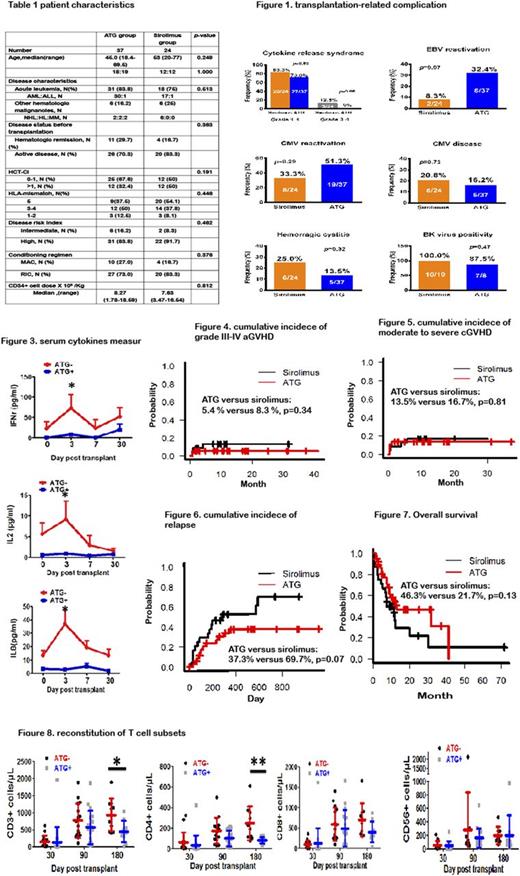Abstract
Introduction:
Post-transplant cyclophosphamide (PtCY) in combination with calcineurin inhibitors overcomes the barrier of haploidentical bone marrow transplantation, but for peripheral stem cell transplantation (HaploSCT), there are concerns about life-threatening cytokine release syndrome (CRS) and increased incidences of acute/chronic graft versus host disease (GVHD). Italy group reported sirolimus decreased incidence of GVHD without increasing disease relapse. Baltimore group reported anti-thymocyte globulin (ATG) combined with PtCy was an efficient alternative for protection from GVHD in non-hematologic diseases; yet it is unknown whether the combination increases the incidence of infection and disease relapse. In our hospital, since initial high incidences of acute GVHD with PtCy and cyclosporine, either sirolimus in substitution for cyclysporine, or ATG was used in combination with PtCY in our patients with hematologic malignancy. Therefore, we conducted a retrospective study to compare the two regimens which aimed to focus on disease relapse, GVHD, viral infection, and CRS.
Methods:
A total of 61 patients with hematological malignancies, who had an HaploSCT at our center from Jan 2013 to Dec 2016. Thirty-seven patients belonged to ATG group with GVHD prophylaxis consisting of rabbit ATG of total of 4.5mg/kg; PtCy of 50 mg/kg on Days +3 and +4 and cyclosporine/mycophenolate(MMF) from Day+5 onwards. Twenty-four patients were stratified into sirolimus group with GVHD prophylaxis consisting of PTCy and sirolimus/MMF.
Results:
Patients characteristics are provided in Table 1. There were no significant differences between ATG and sirolimus group.
CRS was common in both group (ATG versus sirolimus:73% versus 83.3%, p=0.376) as seen in Figure 2. Three patients in sirolimus group developed grade 3-4 CRS. No patient in ATG group had grade 3-4 CRS. Serum cytokine profiles were available in 8 patients of each group. The level of IL2, IFNr and IL8 were significantly suppressed in ATG group compare to sirolimus group as seen in Figure 3. Other cytokines including IL-10, IL12p40,IL-12p70,IL-13,IL-15,IL-17A,IL-9,IL-4,IL-6,IL-7,MIP-1A ,MIP-1B, TNFa,IL-17F,IL-21,IL-23,IL-17E, and IL-27 showed no significant differences.
Thrombotic thrombocytopenic purpura (TTP) occurred in 2 (8.3%) of 24 patients receiving sirolimus. No TTP occurred in ATG group. Hemorrhagic cystitis occurred in 25% patients of sirolimus group and 13.5% patients of ATG group. EBV reactivation occurredhigher in ATG group compared to sirolimus group (32.4% versus 8.3%, p=0.07). No post-transplant lymphoproliferative disorders were observed in both groups. There were 33.3% of CMV reactivation in sirolimus group, and 51.3% in ATG group (p=0.287). CMV diseases developed in 5 (20.8%) of 24 patients in sirolimus group compared to 6 (16.2%) of 37 patients in ATG group (p=0.734).
There was no difference of cumulative incidence (CI) of grade II-IV acute GVHD (aGVHD) (ATG versus sirolimus (95%CI) : 21.9% (10.1%-36.6%) versus 16.9% (5.1%-36.6%), p=0.58) and grade III-IV aGVHD (5.4 % (0.9%-16.1%) versus 8.3% (1.4%-23.7%), p=0.34) at day 100 after HSCT, as seen in Figure 4. Similar CI of chronic GVHD (cGVHD) and moderate to severe cGVHD were noted between groups (cGVHD: ATG versus sirolimus :36.5% (20.7%-52.5%) versus 33.3% (15.3%-52.6%), p=0.58; moderate to severe cGVHD:13.5% (4.9%-26.6%) versus 16.7% (5.0%-34.3%), p=0.81), as seen in Figure 5.
The 2-year non-relapse mortality of ATG versus sirolimus was 21.5% (9.2%-37.1%) versus 12.8% (3.0%-30.0%); p=0.07). The disease relapse of ATG group versus sirolimus group was 69.7% (37.1%-87.7%) versus 37.3% (20.6%-54.1%; p=0.07), as seen in Figure 6. Multivariate analsysis showed only disease risk index was an independent prognostic factor (HR, 95% CI:5.61 (1.02-30.7), p :0.05). The 2-year overall survival of ATG group versus sirolimus group was 46.3% (27.9%-62.9%)versus 21.7%(6.0%-43.8%); p=0.13) as seen in Figure 7.
Fifty-five patients were followed up to determine the reconstitution of T cell subsets, as seen in figure 8. Compared to sirolimus group, ATG group had significantly lower CD3 and CD4 cell counts at day 180.
Conclusion:
ATG combined with PtCy is a feasible option as GVHD prophylaxis. Compared to sirolimus with PtCy, ATG/PtCy led to similar outcomes of overall survival, acute and chronic GVHD. Importantly, ATG did not increase the risk of disease relapse.
No relevant conflicts of interest to declare.
Author notes
Asterisk with author names denotes non-ASH members.


